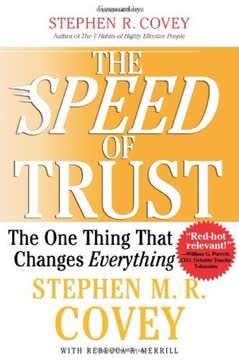Key Takeaways
1. Quiet leadership: The unorthodox path to doing the right thing
The most effective leaders are rarely public heroes. These men and women aren't high-profile champions of causes, and don't want to be. They don't spearhead ethical crusades. They move patiently, carefully, and incrementally.
Redefining leadership. Quiet leadership challenges the conventional heroic model of ethical action. It recognizes that most ethical challenges in organizations are mundane, complex, and require patient, incremental solutions. Quiet leaders focus on making small, meaningful changes over time, often working behind the scenes to improve their organizations and communities.
Characteristics of quiet leaders:
- Patient and careful in their approach
- Work incrementally rather than through grand gestures
- Focus on practical solutions to everyday ethical challenges
- Operate effectively within organizational constraints
- Balance multiple stakeholder interests
Quiet leadership is particularly suited to addressing the complex ethical challenges of modern organizations, where issues are often intertwined with technical, legal, and bureaucratic complexities.
2. Don't kid yourself: Recognize the complexity of ethical challenges
Quiet leaders are realists. They try hard to see the world as it is. This means recognizing, almost as a sixth sense, that all sorts of things can happen and often do.
Embrace complexity. Quiet leaders resist the temptation to oversimplify ethical challenges. They recognize that most situations involve multiple stakeholders, competing interests, and unforeseen consequences. This realistic outlook helps them navigate complex ethical terrain more effectively.
Key aspects of a realistic outlook:
- Acknowledge uncertainty and ambiguity
- Consider multiple perspectives and potential outcomes
- Recognize the limits of one's knowledge and control
- Be prepared for unexpected developments
By adopting a realistic perspective, quiet leaders can anticipate potential pitfalls, develop more robust solutions, and adapt their strategies as situations evolve. This approach helps them avoid the trap of moral absolutism and enables more effective ethical leadership in complex organizational environments.
3. Trust mixed motives: Harness self-interest and altruism
Quiet leaders are often complicated people—more complicated, in fact, than their demeanor usually indicates.
Embrace complexity of motives. Quiet leaders recognize that human motivation is rarely pure altruism or pure self-interest. Instead, they understand that most people, including themselves, are driven by a complex mix of motives. This insight allows them to harness both self-interest and altruism to drive ethical action.
Benefits of recognizing mixed motives:
- Increased resilience and persistence in ethical efforts
- More realistic assessment of others' motivations and behaviors
- Ability to align ethical goals with personal and organizational interests
- Reduced moral paralysis from unrealistic expectations of purity
By accepting and working with mixed motives, quiet leaders can sustain their ethical efforts over time and find creative solutions that satisfy multiple stakeholders. This approach recognizes the reality of human nature and organizational life, leading to more effective and sustainable ethical leadership.
4. Buy time: Create space for reflection and strategic action
Quiet leaders rarely rush forward with "The Answer." Instead, they do something quite at odds with the conventional view of leadership. Instead of charging the hill, they often look for ways to beg, borrow, and steal a little time.
Strategic delay. Buying time is a crucial tactic for quiet leaders facing complex ethical challenges. It allows for deeper analysis, consultation with others, and the development of more nuanced solutions. This approach runs counter to the idea of decisive, immediate action often associated with leadership.
Tactics for buying time:
- Seek additional information or clarification
- Consult with experts or stakeholders
- Propose a phased approach to addressing the issue
- Highlight potential risks of hasty action
By creating space for reflection and strategic planning, quiet leaders can develop more effective solutions to ethical challenges. This approach also allows for the emergence of new information or alternatives that may not be immediately apparent, leading to better outcomes in complex situations.
5. Invest wisely: Balance risks and rewards of ethical decisions
Before they charge a hill, they measure it carefully.
Strategic risk assessment. Quiet leaders approach ethical challenges with a careful consideration of the risks and potential rewards. They recognize that their ability to effect change depends on maintaining their position and influence within the organization. This approach involves assessing one's "political capital" and investing it wisely.
Key considerations in ethical risk assessment:
- Evaluate personal and professional risks
- Assess potential impact on stakeholders
- Consider long-term consequences for the organization
- Identify potential allies and opponents
By approaching ethical challenges as strategic investments, quiet leaders can maximize their impact while minimizing personal and professional risks. This approach allows them to sustain their efforts over time and build credibility for future ethical initiatives.
6. Drill down: Understand the technical and bureaucratic details
Quiet leaders know that moral commitment and high principles are no substitute for immersion in the complexities of a particular situation.
Master the details. Effective ethical leadership often requires a deep understanding of technical and bureaucratic complexities. Quiet leaders invest time and effort in learning the intricacies of their situations, recognizing that ethical solutions must be grounded in practical realities.
Benefits of drilling down:
- Identify hidden opportunities and constraints
- Develop more credible and feasible solutions
- Anticipate potential obstacles and objections
- Build respect and credibility with technical experts
By mastering the details of complex situations, quiet leaders can develop more effective and sustainable ethical solutions. This approach also helps them navigate bureaucratic obstacles and find creative ways to advance their ethical goals within existing systems and processes.
7. Bend the rules: Find creative solutions within ethical boundaries
Quiet leaders are reluctant, for a variety of good reasons, to break the rules, but they don't want to obey them mechanically and cause harm. So they look, imaginatively and creatively, for ways to bend the rules without breaking them.
Creative compliance. Quiet leaders recognize that strict adherence to rules can sometimes lead to unethical outcomes. They seek ways to honor the spirit of ethical guidelines while finding flexible interpretations that allow for more just and effective solutions.
Approaches to bending rules:
- Identify the underlying purpose of rules and regulations
- Seek creative interpretations that align with ethical goals
- Consult with others to explore alternative approaches
- Document and justify departures from standard procedures
By finding ways to bend rather than break rules, quiet leaders can navigate ethical challenges more effectively. This approach allows them to maintain integrity while addressing complex situations that may not fit neatly within existing guidelines.
8. Nudge, test, and escalate gradually: Navigate complex situations
Instead of hunting confidently for the right answer, they concentrate on finding the right ways to eventually get sound, workable answers.
Incremental progress. Quiet leaders recognize that complex ethical challenges often require a gradual, iterative approach. They use small actions to test the waters, learn from feedback, and slowly build momentum for change.
Strategies for gradual escalation:
- Start with low-risk, small-scale initiatives
- Monitor reactions and adjust approach accordingly
- Build alliances and support over time
- Incrementally increase the scope and impact of ethical efforts
This approach allows quiet leaders to navigate complex ethical terrain with reduced risk and increased effectiveness. By moving gradually, they can build support, learn from experience, and adapt their strategies as situations evolve.
9. Craft compromises: Develop practical solutions to ethical dilemmas
Quiet leaders reject this conclusion. To them, it is simply defeatism. As we have seen, they get involved with problems because they take them personally.
Ethical pragmatism. Quiet leaders excel at crafting compromises that address ethical concerns while accounting for practical realities. They recognize that perfect solutions are rare and focus on developing workable approaches that improve the ethical climate incrementally.
Elements of effective ethical compromises:
- Address core ethical concerns while acknowledging constraints
- Involve key stakeholders in developing solutions
- Create mechanisms for ongoing monitoring and adjustment
- Balance short-term actions with long-term ethical goals
By focusing on crafting practical compromises, quiet leaders can make meaningful progress on ethical issues even in challenging organizational environments. This approach recognizes the complexity of ethical challenges and seeks to create sustainable, impactful solutions.
10. Cultivate quiet virtues: Restraint, modesty, and tenacity
These are accessible virtues. They are familiar, natural, sensible ways of thinking and acting. As a result, almost anyone can practice and cultivate the simple virtues of quiet leadership.
Character development. The effectiveness of quiet leadership stems not just from tactics, but from the cultivation of key virtues: restraint, modesty, and tenacity. These qualities enable leaders to navigate complex ethical terrain with patience, humility, and persistence.
Cultivating quiet virtues:
- Restraint: Practice self-control and thoughtful action
- Modesty: Recognize the limits of one's knowledge and influence
- Tenacity: Persist in ethical efforts despite setbacks and challenges
By developing these virtues, individuals can enhance their capacity for quiet leadership. These qualities provide a foundation for effective ethical action in complex organizational environments, allowing leaders to make sustained progress on challenging issues over time.
Last updated:
FAQ
What's "Leading Quietly" about?
- Focus on Quiet Leadership: "Leading Quietly" by Joseph L. Badaracco Jr. explores the concept of quiet leadership, emphasizing modesty, restraint, and incremental change over bold, heroic actions.
- Everyday Leadership: The book argues that effective leaders are often not public heroes but those who work behind the scenes to do what is right for their organizations and people.
- Practical Lessons: It presents stories of quiet leaders at work and draws practical lessons from their efforts, offering a broader perspective on responsible, effective leadership.
Why should I read "Leading Quietly"?
- Alternative Leadership Model: It provides an unorthodox view of leadership that contrasts with the traditional heroic model, offering insights into how real change often happens.
- Practical Guidance: The book offers practical advice and guidelines for those who want to lead effectively without seeking the limelight.
- Relevance to Everyday Life: It is particularly useful for individuals in middle management or those who face ethical challenges in their daily work.
What are the key takeaways of "Leading Quietly"?
- Mixed Motives: Leaders often have mixed motives, and understanding these can help in making more effective decisions.
- Buying Time: Effective leaders often buy time to better understand complex situations before acting.
- Invest Wisely: Leaders should carefully consider how they invest their political capital, aiming for the greatest impact with the least risk.
What is the "risk-return model" in "Leading Quietly"?
- Investment Analogy: The risk-return model in the book likens leadership decisions to investment decisions, where leaders assess the risks and potential returns of their actions.
- Political Capital: Leaders should evaluate how much political capital they have and how much they are willing to risk for a particular outcome.
- Prudent Action: The model encourages leaders to act prudently, balancing courage with careful consideration of potential consequences.
How does "Leading Quietly" define quiet leadership?
- Behind-the-Scenes Work: Quiet leadership is characterized by working behind the scenes, focusing on small, incremental changes rather than grand gestures.
- Modesty and Restraint: Quiet leaders are modest and exercise restraint, often moving carefully and patiently to achieve their goals.
- Practical Wisdom: It involves practical wisdom, where leaders use their understanding of complex situations to craft effective solutions.
What are the best quotes from "Leading Quietly" and what do they mean?
- "Quiet leadership is what moves and changes the world." This quote emphasizes the book's central thesis that real change often comes from modest, behind-the-scenes efforts rather than dramatic actions.
- "There are no old, bold pilots." This quote highlights the value of caution and preparation, suggesting that careful, thoughtful action is often more effective than bold, reckless moves.
- "The better is the enemy of the good." This quote advises against perfectionism, encouraging leaders to focus on practical, attainable solutions rather than ideal but unrealistic ones.
What role does "drilling down" play in quiet leadership according to "Leading Quietly"?
- Understanding Complexity: Drilling down involves thoroughly understanding the complexities of a situation before taking action.
- Gathering Information: It requires gathering detailed information and consulting with experts to make informed decisions.
- Avoiding Simplistic Solutions: This approach helps leaders avoid simplistic solutions and instead develop nuanced, effective strategies.
How does "Leading Quietly" suggest leaders handle ethical dilemmas?
- Mixed Motives: Recognize and accept that motives are often mixed, and use this understanding to navigate ethical challenges.
- Buying Time: Leaders should buy time to fully understand the ethical dimensions of a situation before acting.
- Crafting Compromises: The book encourages crafting compromises that uphold core values while addressing practical realities.
What is the significance of "bending the rules" in "Leading Quietly"?
- Creative Solutions: Bending the rules involves finding creative solutions within the boundaries of existing rules without breaking them.
- Ethical Considerations: It requires careful ethical consideration to ensure that bending the rules does not lead to negative consequences.
- Practical Leadership: This approach is seen as a practical way to achieve goals while maintaining integrity.
How does "Leading Quietly" address the concept of political capital?
- Reputation and Relationships: Political capital is defined as the reputation and relationships a leader has within an organization.
- Risk Assessment: Leaders should assess how much political capital they have and how much they are willing to risk for a particular decision.
- Strategic Use: The book advises using political capital strategically to maximize impact and minimize risk.
What are the three quiet virtues highlighted in "Leading Quietly"?
- Restraint: The ability to hold back and not act impulsively, allowing time for reflection and better decision-making.
- Modesty: Recognizing one's limitations and the role of others in achieving success, fostering collaboration and humility.
- Tenacity: Persistence in the face of challenges, driven by a strong commitment to one's values and goals.
How does "Leading Quietly" redefine success in leadership?
- Small Wins: Success is often about achieving small wins that cumulatively lead to significant change.
- Process Over Outcome: The book emphasizes the importance of the process and the journey, rather than just the end result.
- Impact on Others: Success is also measured by the positive impact on others and the organization, not just personal achievements.
Review Summary
Leading Quietly presents an alternative view of leadership, focusing on everyday, behind-the-scenes leaders who make incremental changes through pragmatism, restraint, and ethical decision-making. Readers appreciate its realistic approach to complex situations, though some find it repetitive or overly cautious. The book challenges the notion of heroic leadership, instead emphasizing the importance of thoughtful problem-solving and compromise. While some critics argue it rationalizes working within broken systems, others find its advice on navigating ethical dilemmas in the workplace valuable and refreshing.
Similar Books







Download PDF
Download EPUB
.epub digital book format is ideal for reading ebooks on phones, tablets, and e-readers.





